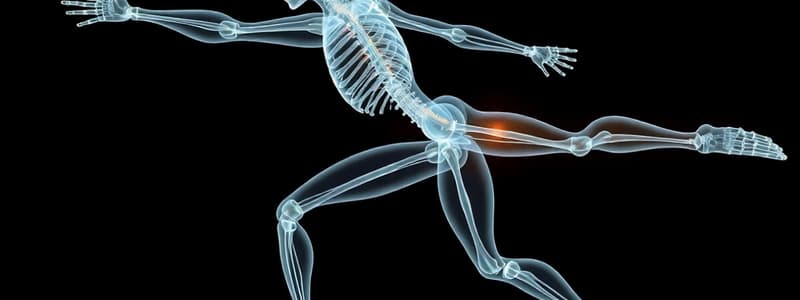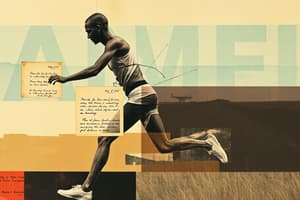Podcast
Questions and Answers
Which system is primarily responsible for interpreting sensory input to inform motor control?
Which system is primarily responsible for interpreting sensory input to inform motor control?
- Cognitive system
- Sensory/Perceptual system (correct)
- Motor/Action system
- Neuromotor system
A therapist is designing an exercise for a patient with balance issues. Which sensory component should they prioritize to improve balance control?
A therapist is designing an exercise for a patient with balance issues. Which sensory component should they prioritize to improve balance control?
- Tactile
- Vestibular (correct)
- Visual
- Auditory
During the response selection stage, what is the primary function?
During the response selection stage, what is the primary function?
- Translating the movement idea into muscular actions.
- Executing the planned movement.
- Sensing and processing information about the environment.
- Developing a plan for purposeful movement. (correct)
A pianist is able to play a complex piece without consciously thinking about each individual note. Which concept of motor control best explains this ability?
A pianist is able to play a complex piece without consciously thinking about each individual note. Which concept of motor control best explains this ability?
In which stage of information processing does the CNS translate the idea for movement into muscular actions?
In which stage of information processing does the CNS translate the idea for movement into muscular actions?
Which of the following is NOT a key element of motor control?
Which of the following is NOT a key element of motor control?
What is the role of muscle synergies in motor control?
What is the role of muscle synergies in motor control?
A person touches a hot stove and quickly pulls their hand away. Which stage of information processing is MOST responsible for the immediate initiation of this movement?
A person touches a hot stove and quickly pulls their hand away. Which stage of information processing is MOST responsible for the immediate initiation of this movement?
A physical therapist is working with a patient who is learning to walk on a treadmill. The therapist adjusts the speed and incline of the treadmill to challenge the patient. This adjustment primarily affects which type of environmental constraint?
A physical therapist is working with a patient who is learning to walk on a treadmill. The therapist adjusts the speed and incline of the treadmill to challenge the patient. This adjustment primarily affects which type of environmental constraint?
A child is learning to catch a ball. Initially, they rely heavily on visual feedback to track the ball's trajectory and adjust their hand position. As they improve, they begin to anticipate the ball's arrival and adjust their movements before receiving visual feedback. Which control process is MOST associated with the improvements?
A child is learning to catch a ball. Initially, they rely heavily on visual feedback to track the ball's trajectory and adjust their hand position. As they improve, they begin to anticipate the ball's arrival and adjust their movements before receiving visual feedback. Which control process is MOST associated with the improvements?
Consider a task that requires a person to maintain their balance while standing on a moving bus. Which combination of task constraints is MOST relevant to this scenario?
Consider a task that requires a person to maintain their balance while standing on a moving bus. Which combination of task constraints is MOST relevant to this scenario?
A patient with a neurological condition exhibits difficulty initiating movements. According to the Motor Programming Theory, what could be a potential underlying issue?
A patient with a neurological condition exhibits difficulty initiating movements. According to the Motor Programming Theory, what could be a potential underlying issue?
During a physical therapy session, a patient is practicing sit-to-stand transfers. Which combination of task constraints BEST describes this activity?
During a physical therapy session, a patient is practicing sit-to-stand transfers. Which combination of task constraints BEST describes this activity?
A person is walking through a crowded shopping mall. Which of the following represents a non-regulatory environmental constraint?
A person is walking through a crowded shopping mall. Which of the following represents a non-regulatory environmental constraint?
According to Hierarchical Theory, which of the following motor control impairments is MOST likely following a stroke that damages higher-level brain centers?
According to Hierarchical Theory, which of the following motor control impairments is MOST likely following a stroke that damages higher-level brain centers?
A gymnast performing a floor routine is an example of what kind of task?
A gymnast performing a floor routine is an example of what kind of task?
Flashcards
Motor Control
Motor Control
Ability to regulate or direct mechanisms essential to movement.
Key elements of motor control
Key elements of motor control
The individual, the task, and the environment.
Motor/Action System
Motor/Action System
Neuromotor and biomechanical systems that control muscles and joints in a coordinated way.
Sensory/Perceptual System
Sensory/Perceptual System
Signup and view all the flashcards
Cognitive System
Cognitive System
Signup and view all the flashcards
Stimulus Identification Stage
Stimulus Identification Stage
Signup and view all the flashcards
Response Selection Stage
Response Selection Stage
Signup and view all the flashcards
Response Programming
Response Programming
Signup and view all the flashcards
Feedforward Control
Feedforward Control
Signup and view all the flashcards
Feedback Control
Feedback Control
Signup and view all the flashcards
Mobility (Task Constraint)
Mobility (Task Constraint)
Signup and view all the flashcards
Postural Control (Task Constraint)
Postural Control (Task Constraint)
Signup and view all the flashcards
Discrete Task
Discrete Task
Signup and view all the flashcards
Continuous Task
Continuous Task
Signup and view all the flashcards
Regulatory Features
Regulatory Features
Signup and view all the flashcards
Non-Regulatory Features
Non-Regulatory Features
Signup and view all the flashcards
Study Notes
- Motor Control: The ability to regulate or direct mechanisms essential to movement.
- Motor control is the field that studies the nature of movement and how it's controlled.
Key Elements of Motor Control:
- The individual generates movement.
- Movements must meet the demands of a specific task,
- Movements occur within a specific environment.
System Overview
- Motor/Action: Involves the neuromotor and biomechanical systems; muscles and joints must be controlled in coordinated ways.
- Sensory/Perceptual: Involves peripheral sensory and higher-level processing.
- Sensory Component: Provides information regarding the state of the body and environment and includes vestibular, kinesthetic, proprioception, auditory, visual, and tactile input.
- Perceptual Component: Interpretation of sensory input
- Cognitive: Attention, planning, problem-solving, motivation, and emotion; it establishes intent or goals.
Stages of Information Processing in the CNS for Movement Production:
- Stimulus Identification Stage: Sensing, planning, and memory contact stage, which considers the state of the body, movement, and the environment, including memory based on past experiences.
- Response Selection Stage: This is the interpreting, planning, and deciding stage where a plan for purposeful movement is developed and a motor plan is generated, that are made up of stored motor programs.
- Response Programming: Involves translating, structuring, and initiating the stages when neural centers translate the idea for movement into muscular actions defined by a motor program.
Motor Program
- It's an abstract representation that, when initiated, results in a coordinated movement sequence.
- Motor programs free up the nervous system from conscious decisions.
- They utilize muscle synergies (functional linked muscles) to simplify control.
- Parametric specification is based on constraints of the individual, task, and environment.
- Response Execution: Represents the movement output and involves feedforward and feedback controls.
- Feedforward Control: Sending of signals in advance of movement to ready the system for incoming sensory signals.
- Feedback Control: Response-produced sensory information received during or after the movement and used to monitor movement output for corrective action.
Task Constraints:
- Task constraints include mobility, postural control, and upper extremity function.
- Discrete vs. Continuous: Discrete movements have a recognizable beginning and end; continuous, the performer decides when to end. EX: Discrete - gymnastics routine. Continuous - walking, skipping, jumping jacks.
- Open vs. Closed: Open movements are unpredictable and require adaptation; closed are fixed and predictable.
- Stability vs. Mobility: Stability involves a non-moving base of support; mobility involves a moving BOS (walking, running, jumping).
- Manipulation vs. Non-Manipulation: Manipulation involves upper extremity (UE) function; non-manipulation does not.
Environmental Constraints:
- Regulatory Features: Shape movement EX: cup size, height of step/chair, surface of ground.
- Non-Regulatory Features: May affect/influence movement but does not shape/conform EX: background noise, distractions.
Dual Task:
- Motor skills are the ability to perform a task while doing a secondary task (primarily cognitive or motor EX: walking and talking.
Simple Task:
- Simple motor program EX: kicking a ball one time
Complex Task:
- Involve multiple actions EX: kicking a ball while running
Theories of Motor Control:
- Reflex Theory: Early theory based on reflexes as building blocks of movement that are chained together EX: reflex chaining . This has many limitations.
- Hierarchical Theory: Builds on the reflex theory, realizing that reflexes are modified to adapt to tasks through CNS commands. The basic assumption is that the brain controls all movement/top-down. Limitations to this theory.
- Motor Programming Theories: Assumes we have patterned motor responses; hardwired neural connections allow stereotypical movement (central motor pattern or motor program). Incorporates top-down and bottom-up control. Limitations include that a central motor program cannot be only determinant of an action.
- Clinical implications that interventions should focus on retraining movements important to a functional task (not isolated muscles).
- Systems Theory: Integrates many previous theories and reflects current interpretation of nervous system function, describes the process by which various brain and spinal centers work together to produce movement while also considering internal and external factors.
- Systems theory reflects distributed model of control from many interacting systems, and it allows for flexibility of motor patterns that can adapt to the task and environment.
Studying That Suits You
Use AI to generate personalized quizzes and flashcards to suit your learning preferences.




